Review GSM phone Pantech PG-3200
Pantech
PG-3200. Live pictures
Package:
- Handset
- Battery
- Charger
- Manual
The phone Pantech PG-3200 is a miniature clamshell with two colour screens and a VGA camera with the dimensions of 75x38x21.5 mm and weighing 70 g. Due to its size, the handset is certainly intended for women most of all since it just sinks into a man's hand.

The device has a quite original design: almost every line is straight, except a rounded lower part, and the edges are not smoothed. A small external aerial is trapezium-shaped and matches the phone body a great deal. The device looks bigger than it is, for a feeling of its diminutiveness comes after you take it in hand.

The greater part of the phone surface has a smooth silvery covering. The front panel is seamy and varies in colours which are three - black, silver and red.

The phone body is made of rather a good plastic and the assembling also rouses no censure as all the details fit very well. The device can be easily opened with one hand thanks to hollows on the sides.

The front surface has a small external TFT screen with the resolution of 96x64 pixels (21x14 mm) which is capable of showing 262K colours. The screen is not centred and placed towards the left top. In standby mode it shows a line of service icons as well as a clock and a date. At an incoming/outgoing call it shows the subscriber's number or name and photo or image full-screen (if one is assigned). Besides, the screen could also serve as a viewfinder in case you like to take a self-portrait.

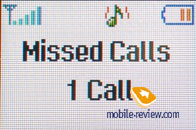

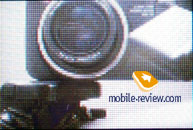
The image quality is quite good and the image is bright and clear. It fades in the sun, information remains readable nevertheless.
The main drawback of the screen is that, when the handset opened, it keeps running and at an incoming/outgoing call the subscriber's number/name, appropriated photo and call time are indicated. I fancy there are few people who like if a near person could get aware of whom you are calling and admire your interlocutor's photo.

Except the external screen, the front panel also has a flash and a camera lens. Since the device lacks a separate loudspeaker for ring signals and the main loudspeaker serves this purpose, the cover has three apertures to turn up the signal volume.

There is a hardwire headset connector shielded with a rubber shutter fixed to the body and two volume keys on the left side surface. The upper one also serves as a camera key and the lower one activates the flash (can be used as a torch) for 30 seconds.

The top has a strap hole and there is an interface connector shielded with a rubber shutter fixed to the body on the bottom.
Having opened the phone you can see an internal TFT screen with the resolution of 128x128 pixels (28x28 mm) which is capable of showing 262K colours. The screen is good, though the image quality yields to that of Samsung screens.

Keys of the keypad are rather modest in size and well distributed. The navigation button is round and medium in size, and it has an OK key inserted. That is very handy and runs alright. The number keys are placed vertically in three rows and their situation is a close terraced one. The number keypad is handy as well and mistypes occur very rarely. The keys have both Cyrillic (the bigger font) and Latin. The backlight of bright blue is even.

The whole back surface is occupied by an accumulator battery that also serves as a back cover. The Li-Ion battery has the capacity of 730 mAh. According to the manufacturer, the device is able to work up to 160 hours in standby mode and to 2.5 hours in talk mode. In the condition of Moscow MTS network the handset has worked for 3 days in case of 20 minutes of talks and up to 10-15 minutes of using other functions a day. Full charge takes 2 hours approximately.

Menu
PG-3200 succeeded the elder models PG-3000, GF500 in software almost entirely. The main menu is represented once, as distinct from the elder models. This is three rows of three icons and when an item is selected it is highlighted and its title is indicated at the top. The submenu is represented as vertical lists and has a quick navigation using number sequences. Some sub-items do not require entering, for the information of actions that could be taken shows at the foot of the screen and an action is selected by a navi button horizontal deviation.


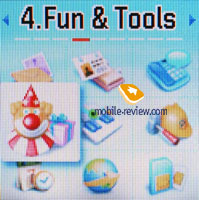

The menu localisation is carried out at mean level. Some titles are abbreviated and this is not so acceptable.
The phone has 8.4 Mb of embedded memory that is dynamical distributed among applications.

Phone book. The device holds up to 800 numbers. Entries are shown both separately from the phone memory or SIM-card and altogether. Each entry could have a name, up to three numbers, and two e-mails. Moreover you may assign a ring tone, a photo or a video to show at a call and put into one of ten caller groups. One can either use 4 preset groups or create a new one. Any group has a name of up to 19 characters and a ring tone.
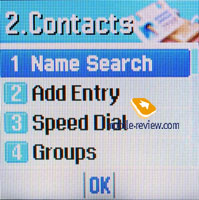

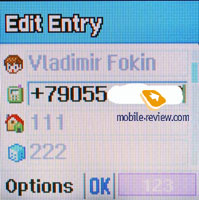
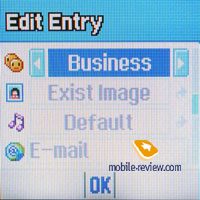
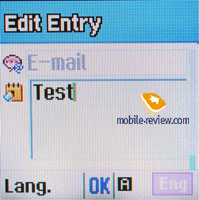
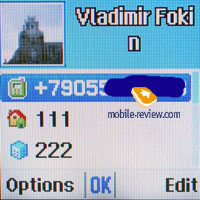
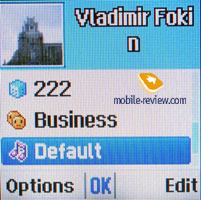
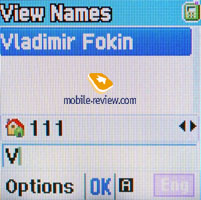
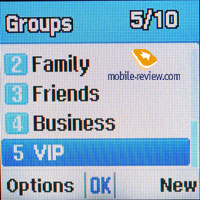
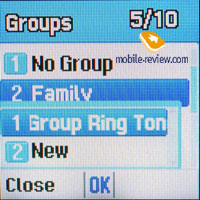
There is a speed dialling of up to 99 numbers. A search in the phone book is made by a name, group, and photo (video) as well as by a speed dialling number.
At an incoming call photos or videos assigned to callers are shown full screen and the name (if the number is contained in the phone book) and a group title.

Messages. The handset contains up to 170 messages. Incoming messages are saved to a SIM-card at first and, after it is filled, to the device memory. There is an opportunity of creating text templates. Unfortunately the phone does not support EMS standard. There is a multi-distribution to 5 numbers at most. An MMS editor is clear and simple and you can create 2 slides at most. It is significant that an MMS message could not be sent via e-mail as the address field must contain only numbers.
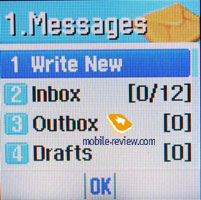
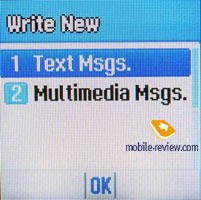
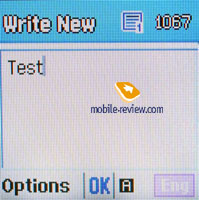
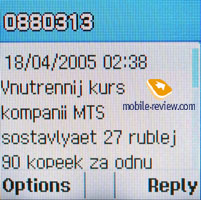
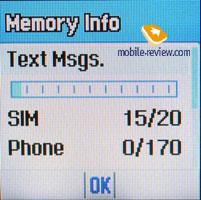

Mere three melodies are available for message alerts and a repetition could be set for every two or five minutes.
Call list. Here you can view the information of dialled, received and missed calls. The equal numbers are combined and the quantity of dialled/received calls is shown next to a number.
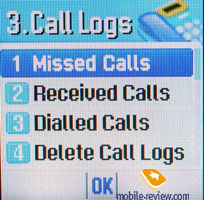

Sound. The sound settings hold a call type - vibra, signal, progressive signal, vibra and signal altogether, first vibra and then signal. There is an opportunity of assigning MP3 melodies as a call alert, but their capacity must be within 300 Kb.

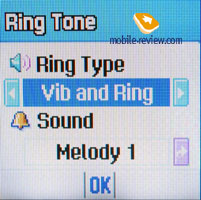
Settings. This includes everything concerned with the phone, network, screen, sound, and other settings. One of three preset images (including one animated) and any picture uploaded by the user or taken with the camera can be assigned as a wallpaper. You may also choose a screensaver in standby mode. One of the offered variants of clock and calendar displaying is to be chosen for the main screen. The backlight time runs from 5 seconds to 10 minutes and the contrast are adjusted at 8 levels.

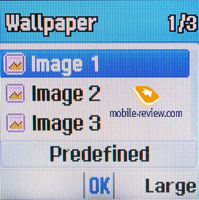


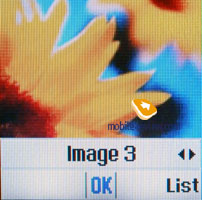

There is also the menu 'Favourites' - this is the user's own menu for a quick access to frequent used functions. In standby mode it is possible by a navi button left deviation.
Organizer. Alarm-clock. You may set 5 independent alarm-clocks and each of them could activate once, daily or from Monday till Friday (till Saturday).
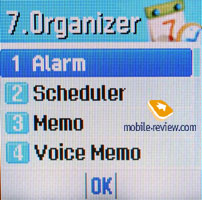
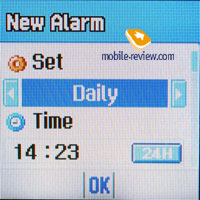

Calendar. A view of either a whole month or the entire event list is possible. An event has a mark (birthday, meeting, trip etc.), time, a text note, an alert, activation time (in time or in a period from 15 minutes to 1 day before the event), date of commencement and one of expiration. There is a limitation of 50 messages in all.
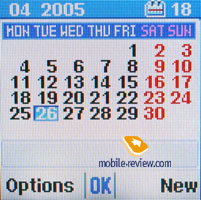
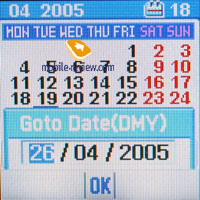
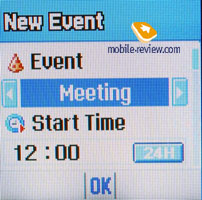
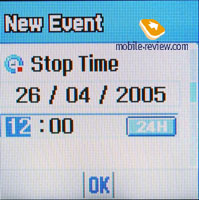
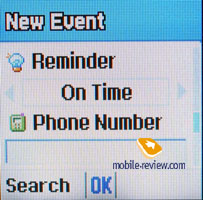


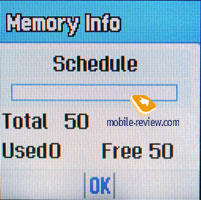
Notebook. Creating text notes of up to 255 characters is possible.

Besides, the device has a world time, a simple calculator, a unit convector, a stopwatch (up to 5 intermediate values), and a timer.
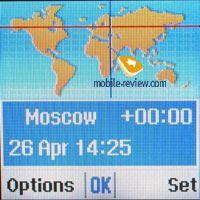

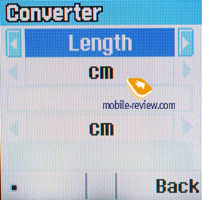

Voice notes. This allows recording voice notes of 60 seconds at most.

Fun and Tools. Camera. The handset is equipped with a VGA camera of CCD matrix. Both the external and internal screens serve as a viewfinder. The device supports two following resolutions - VGA (640x480), LCD (128x160). Taking a series of from 4 to 15 pictures in a certain period is possible. The flash can be in automatic, online or off. The flash is not worth anything special to say since it is rather a bright torch and would little help while taking photos in the dark. Pictures are saved to the default folder, otherwise you should create your own folders.
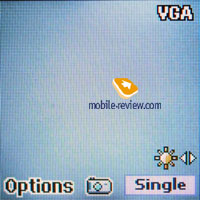

A photo album permits viewing pictures in lists (only file titles), miniatures (6 photos on the screen) and full-screen (one photo is shown).
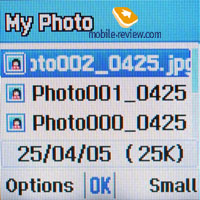
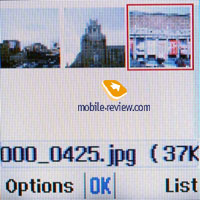
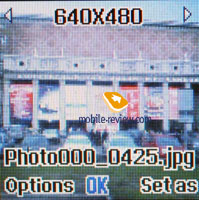
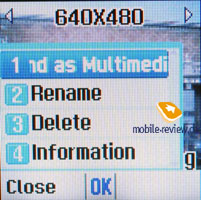

The photo looks good on the phone screen, yet I have failed in transmitting photos to a PC since the device lacks an IrDA gap and a cable is not supplied with the model. Owing to the impossibility of transmitting photos to a PC, appreciating the advantage of CCD matrix over CMOS one is impossible too.
The folders 'Sounds' and 'Images' contain files uploaded by a user.
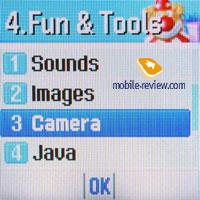
Java. The handset supports MIDP 2.0. There is a preset arcade game Aqua. Installing other ones has run with no trouble.
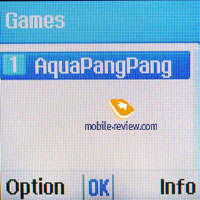

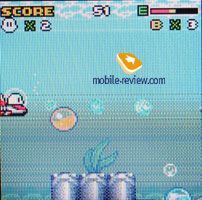
Connections. This menu holds an access to a WAP browser of 2.0 version.
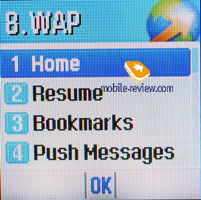
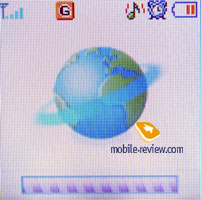
Impressions
The device is quite good in connection quality as there has been no trouble. The loudspeaker volume as well as the microphone sensitivity suffices almost under any condition. The sound of 64-voice polyphony is rather good and the alert volume is enough. Still the vibracall has let down as it is modest in power and sometime you could miss it.
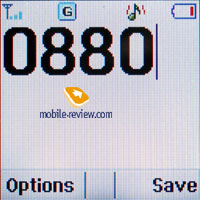
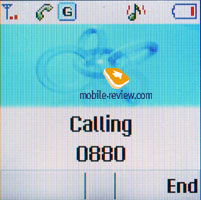


As a result we have the following: a small nice handset that fits the undemandable consumer. The advantages which are worth mentioning consist of the good external screen, the loud polyphony, the phone book of 800 numbers. Unfortunately some functions are restricted compare to the elder models, specifically EMS support is lacking, there is no way of sending MMS to an e-mail, few functions concerned with the camera, the lack of an IrDA gap and therefore photos taken with the camera can be only used on the device or sent with MMS.
The model will enter the market in May 2005 and meanwhile its cost is unknown. If it exceeds 250 USD, the handset won't be in demand. See the competitors - Fly
Z300, Samsung S300, Voxtel V300. The preceding models are comparable to Pantech PG-3200 in functionality.
Melody samples ( 360 KB, mp3)
Vladimir Fokin (vladimir.fokin@mobile-review.com)
Translated by Maria Mitina (maria.mitina@mobile-review.com)
Published - 29 April 2005
Have something to add?! Write us... eldar@mobile-review.com
|















































































